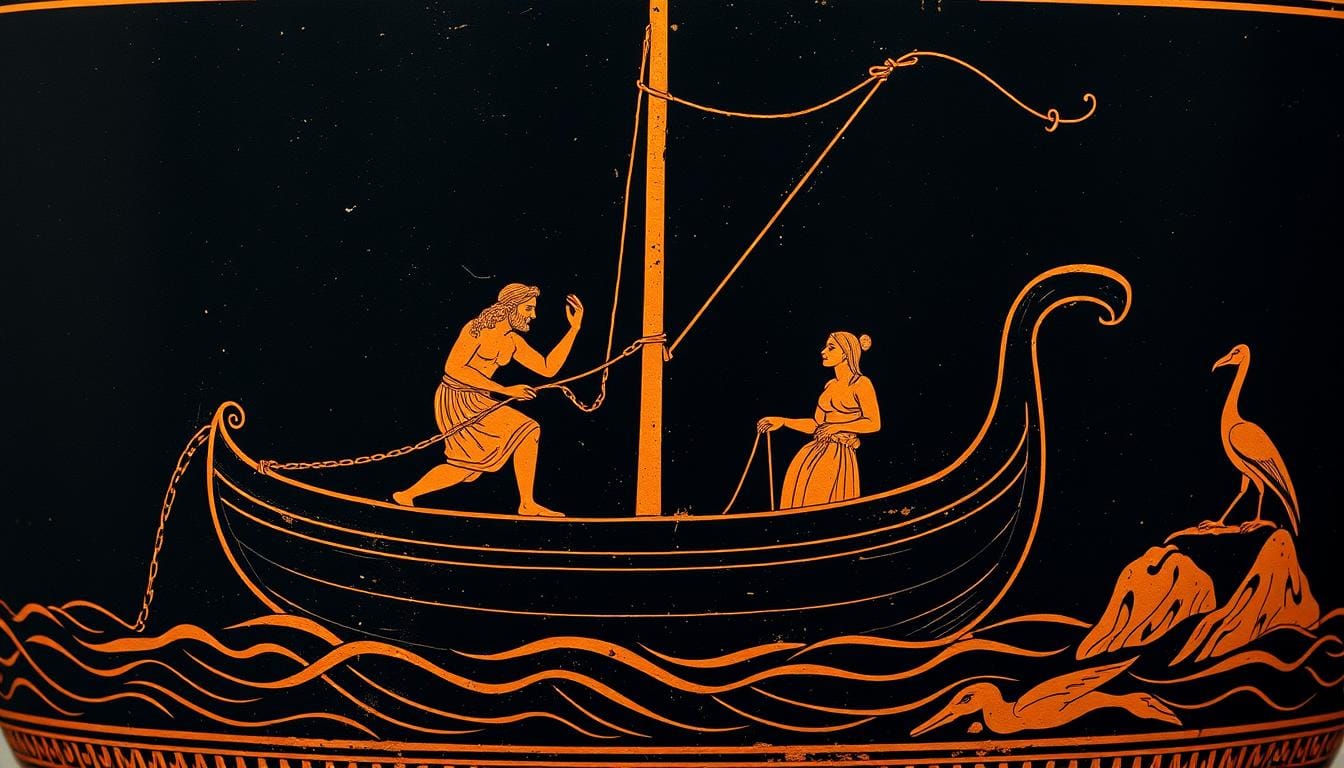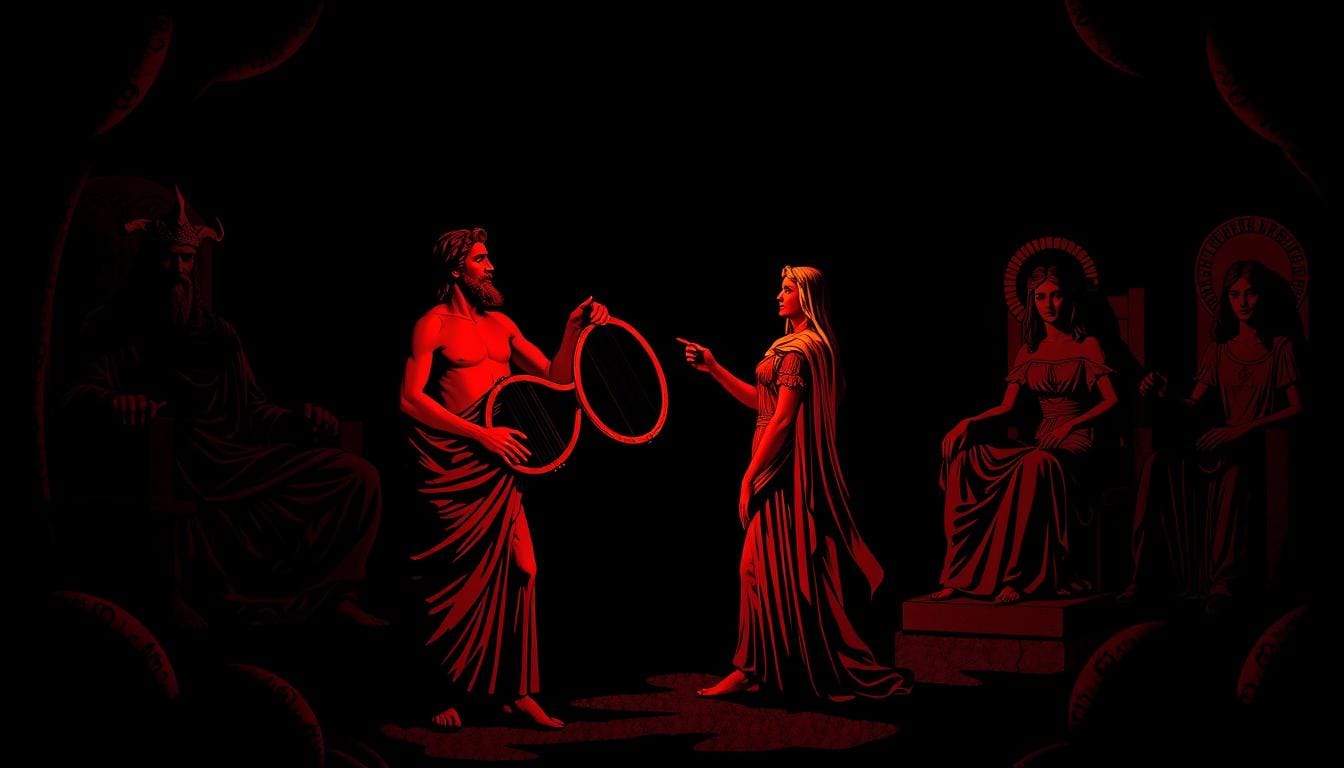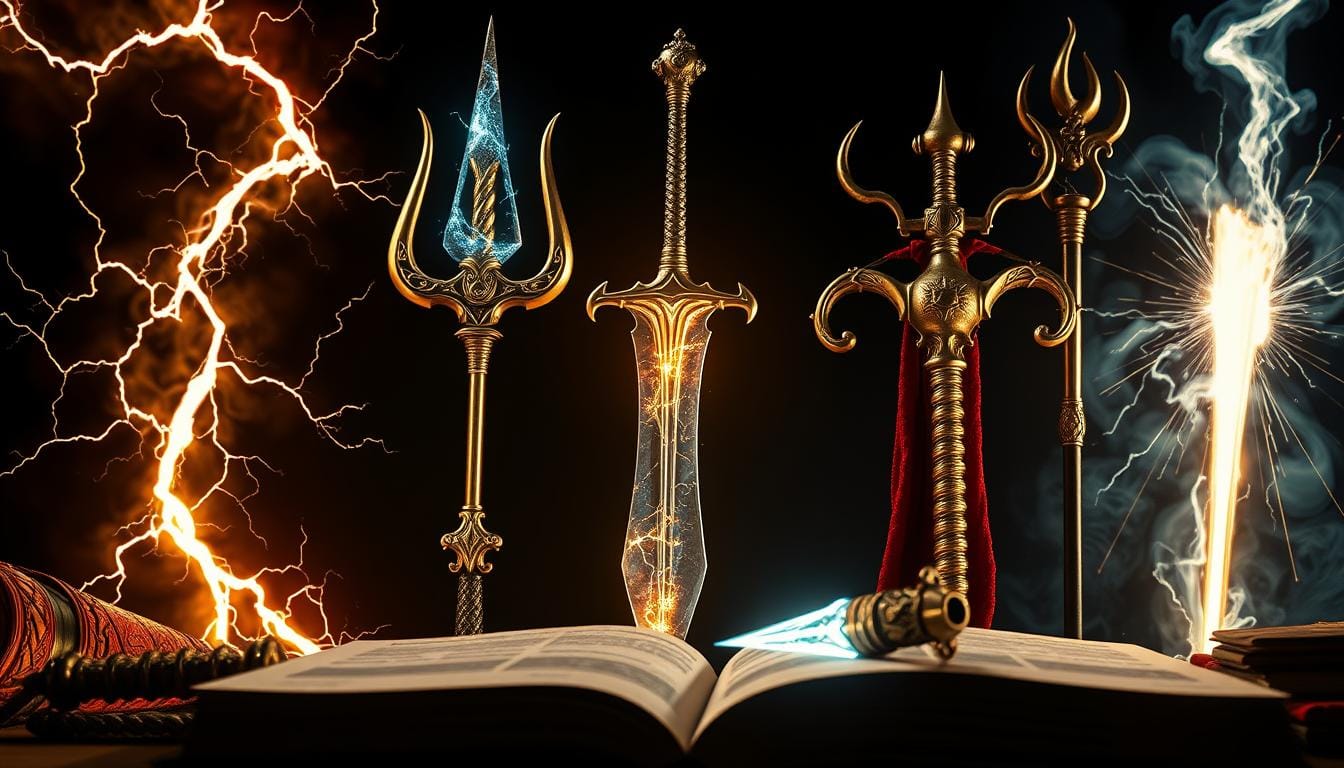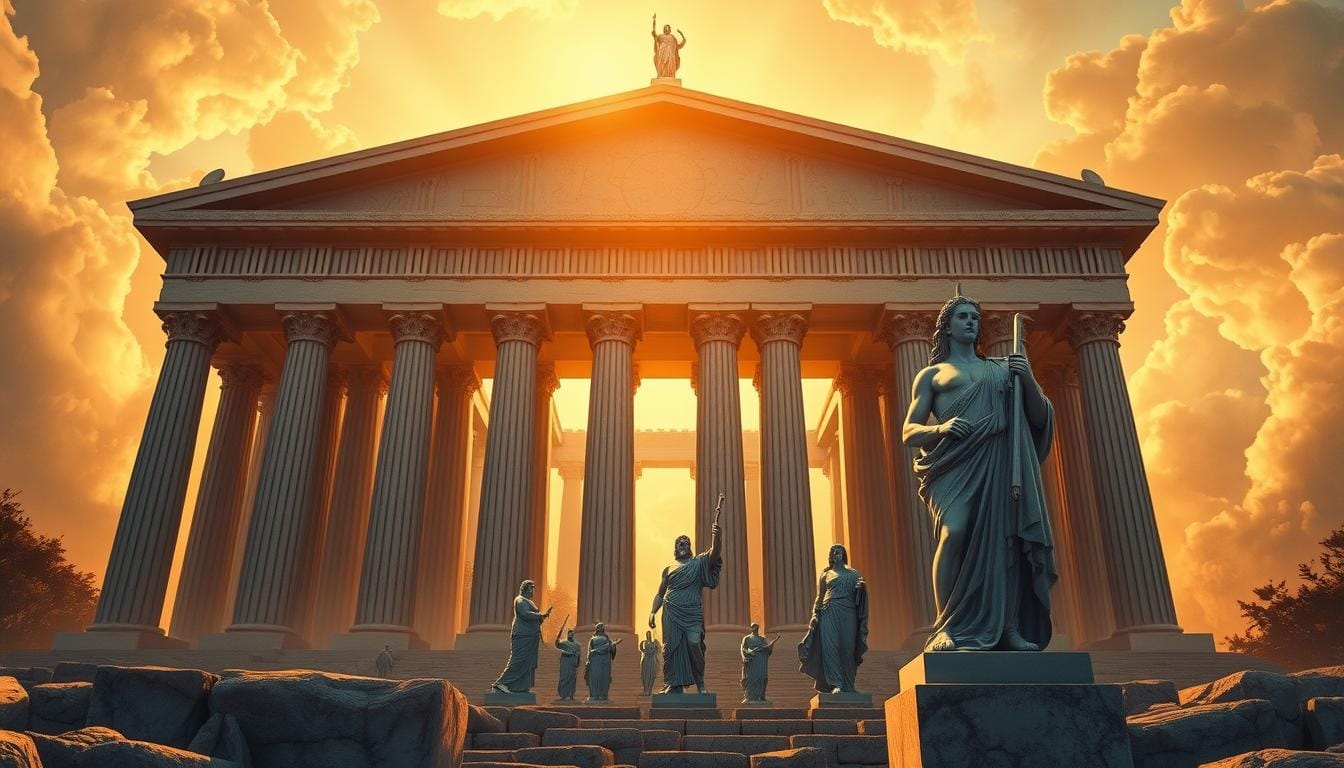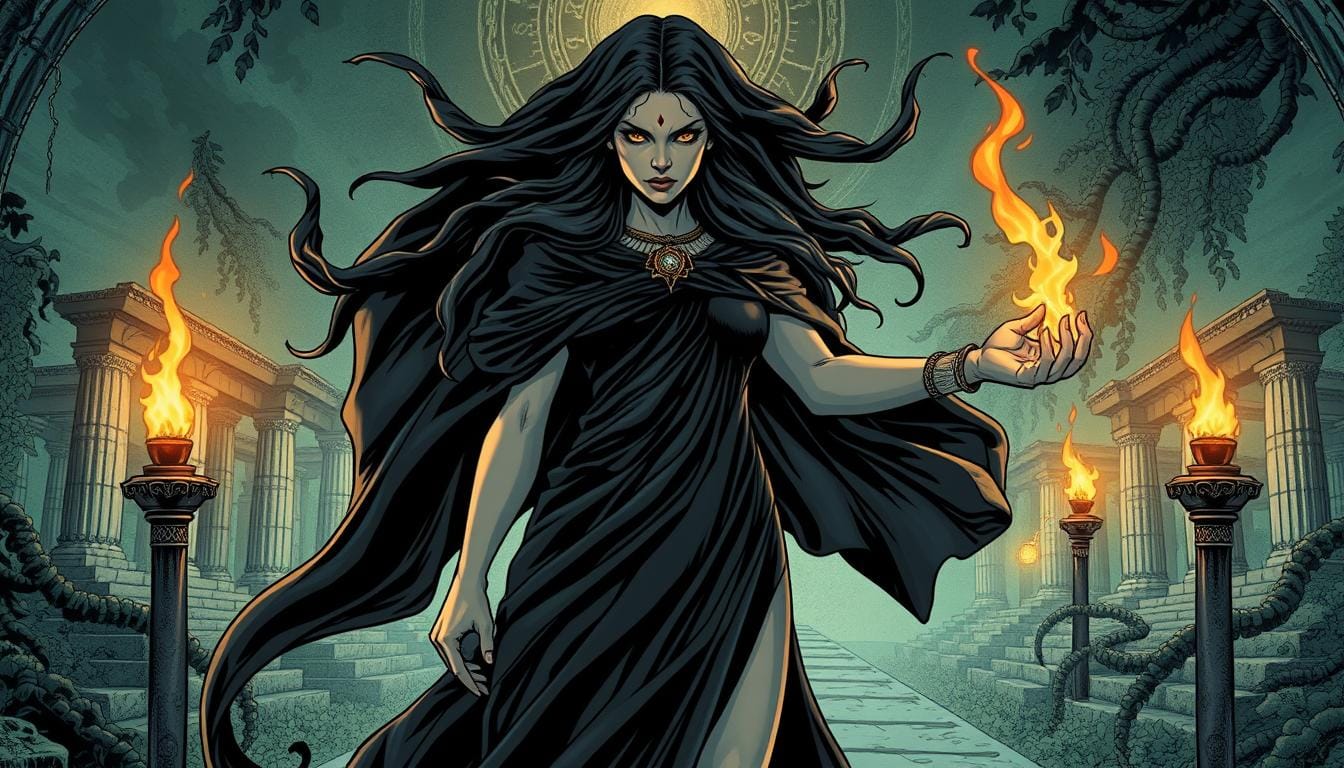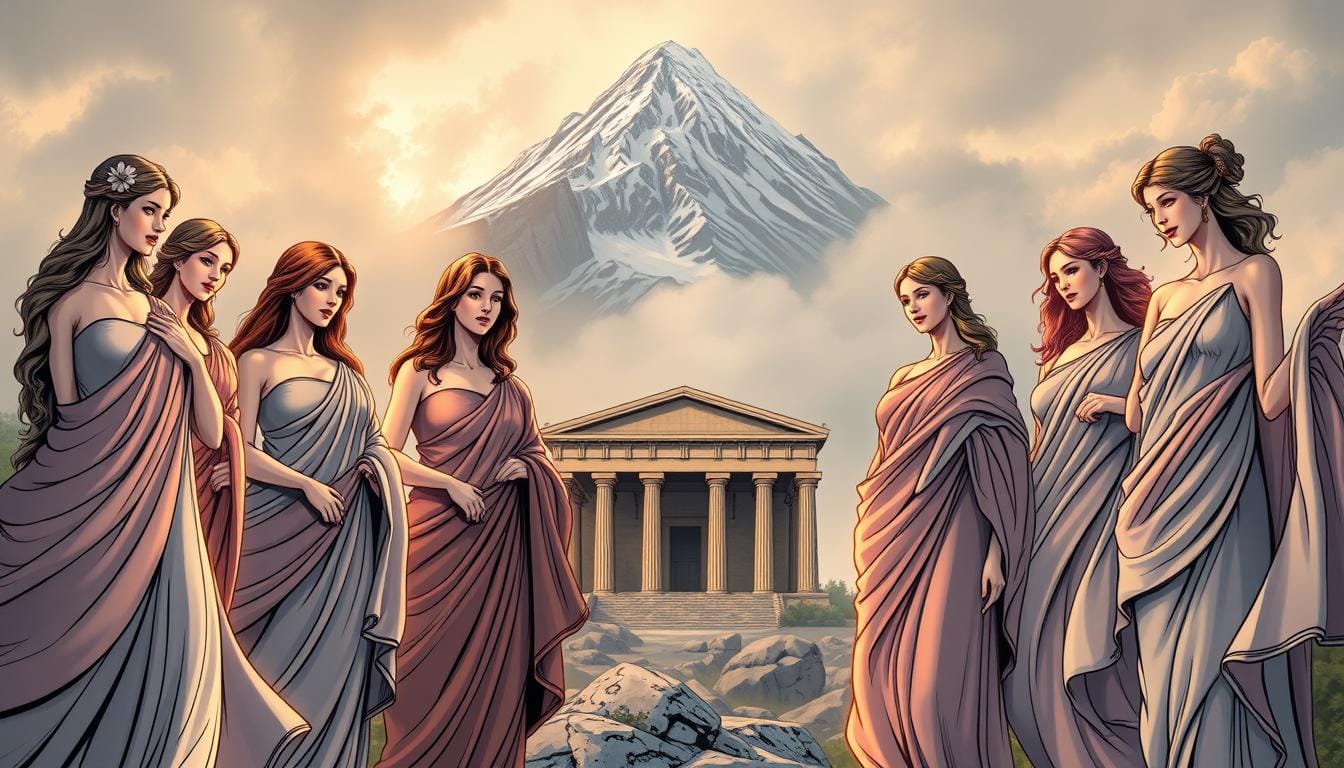Join us as we explore the world of Poseidon, a key figure in ancient Greek mythology. This greek sea god controls both calm waters and fierce storms. He is a powerful presence in myths.
We’ll take you on a journey through Greece’s beautiful coastlines and the stories that have shaped maritime culture for ages. You’ll see temples by the Aegean Sea and hear tales that sailors share. Poseidon’s influence is felt in every wave.
His stories are not just old tales but living stories that spark wonder. Whether you’re visiting sites dedicated to him or learning about Greek coastal life, Poseidon’s story is rich. It’s filled with myth, power, and human connection.
Key Takeaways
- Poseidon ranks among the most formidable deities in Greek mythology as ruler of the seas
- His stories deeply influence maritime culture and coastal traditions throughout Greece
- Ancient temples and sacred sites dedicated to this sea god, including the Temple of Poseidon at Sounion, attract visitors today
- The deity’s complex character reveals both protective and destructive aspects of ocean power
- These mythological tales continue to shape modern understanding of Greek cultural heritage
- Travelers can experience living connections to these ancient stories at coastal destinations
The Mythological Origins and Background
To grasp Poseidon’s rise as a olympian deity, we must go back to the time of Titans. His story is set against a backdrop of divine family drama. This drama is so intense, it would make today’s soap operas seem mild.
The story starts with fear, prophecy, and a father’s desperate bid to keep power. We’ll see how this origin story shaped Poseidon’s character and the Greek divine world.

Birth Among the Titans and Olympian Rise
Poseidon’s birth story is a nightmare wrapped in prophecy. He was born to Titans Cronus and Rhea. His father, Cronus, was consumed by fear of being overthrown by his children, just as he overthrew his father, Uranus.
Cronus’s solution was to swallow each newborn child whole. This kept the prophecy from coming true. Poseidon and his siblings, Hestia, Demeter, Hera, and Hades, were trapped in this dark prison.
Everything changed with Zeus’s birth. Rhea, tired of losing children, hid Zeus and gave Cronus a stone instead. This trick worked perfectly.
When Zeus grew up, he freed his siblings. He used a powerful emetic to make Cronus vomit up the swallowed children. Imagine Poseidon’s first breath of real air after years of imprisonment! This rescue made him a olympian deity, ready to claim his place among the gods.
Division of the Universe with Zeus and Hades
After defeating the Titans, the three brothers had to decide how to divide the universe. They chose to draw lots, a decision that would shape Greek mythology for centuries.
This wasn’t just a game of chance. It was a cosmic treaty that established the natural order. The results influenced everything from navigation to religious ceremonies.
Zeus got the heavens and became the king of gods. Hades took the underworld and control over the dead. Poseidon claimed the seas, oceans, and all waterways, making him a key deity in Greek mythology.
| Brother | Domain Received | Primary Responsibilities | Symbolic Power |
|---|---|---|---|
| Zeus | Sky and Heavens | King of Gods, Weather Control | Lightning Bolt |
| Poseidon | Seas and Oceans | Marine Life, Earthquakes, Horses | Trident |
| Hades | Underworld | Death, Afterlife, Mineral Wealth | Helm of Darkness |
| All Three | Earth (Shared) | Mortal Affairs, Natural Balance | Combined Authority |
This division created a fascinating dynamic among the brothers. Their domains often overlapped on Earth. Poseidon’s earthquakes could affect Zeus’s weather patterns. Hades’ influence touched the underground springs that fed Poseidon’s rivers.
The relationship between these olympian deity figures wasn’t always peaceful. They had legendary conflicts, like Poseidon’s contest with Athena for Athens’ patronage. Yet, their cooperation was key to maintaining cosmic balance.
Understanding this origin story shows why ancient Greeks revered and feared the sea. Poseidon wasn’t just another god. He was a survivor, a brother to the king of gods, and a divine force shaped by both trauma and triumph.
Sacred Symbols and Divine Attributes
Sacred symbols around Poseidon tell a story of divine power. His trident and messengers are key. These symbols were more than art; they connected people with the sea.
In Greek museums, these symbols appear across centuries. They carry deep meanings, connecting people with Poseidon, the sea god.
The Trident: Ultimate Symbol of Sea Power
The trident is Poseidon’s most famous symbol. It’s a three-pronged spear that shows his control over the oceans. The Greeks believed it was made in the sea itself.
This trident symbolizes water’s three aspects. It shows water’s life-giving and destructive sides. It also connects the mortal world to the divine.

Artists often showed the trident because of its importance. When Poseidon used it, earthquakes and storms followed. It was a powerful reminder of his power.
Horses, Bulls, and Sacred Animals
Poseidon was also linked to horses, which might surprise us today. The Greeks saw a connection between ocean waves and horses. Both were powerful and awe-inspiring.
Bulls were also important to Poseidon. They showed his power in creation and destruction. Their strength was like tsunamis, and their fertility was like the sea’s.
Ancient Greeks would sacrifice white bulls to Poseidon. White symbolized the sea’s foam and divine purity. These rituals kept communities connected to the sea god.
Dolphins and Marine Creatures
Dolphins were Poseidon’s messengers, connecting the divine and mortal worlds. Sailors believed dolphins guided lost ships. They showed the sea god’s protective side.
Greek coastal communities respected dolphins. Seeing dolphins was seen as a sign from Poseidon. This belief shaped their relationship with marine life for generations.
Other sea creatures were also sacred. Fish represented abundance, and seals connected land and water. Even sea monsters reminded of the ocean’s mysteries.
| Sacred Symbol | Primary Meaning | Cultural Significance | Modern Recognition |
|---|---|---|---|
| Trident | Divine authority over seas | Three-fold nature of water | Universal symbol of sea power |
| Horses | Untamed natural forces | Connection to wave movement | Featured in art and literature |
| Bulls | Creative and destructive power | Sacrificial offerings | Symbol of strength and fertility |
| Dolphins | Divine messengers | Protection for sailors | Marine conservation symbol |
These symbols are not just for ancient people; they influence our view of the sea today. At Greek archaeological sites, we see these powerful images.
Understanding these symbols shows why Poseidon was so important in Greek history. His symbols spoke to basic human experiences with nature, and the sea’s power.
Poseidon's Domains and Supernatural Powers
Poseidon was more than just the god of the sea. His powers reached into every corner of the natural world. He controlled earthquakes, freshwater sources, and even created amazing creatures. The ancient Greeks saw him as a powerful deity whose influence touched their lives in many ways.
Poseidon’s vast authority made him a key figure for ancient societies. Coastal communities relied on his favor for safe voyages and fresh water. His ability to create and destroy made him both respected and feared.
Master of Seas, Oceans, and Waterways
As the ruler of the ocean, Poseidon controlled all water on Earth. His power included seas, rivers, lakes, and streams that supported civilizations. Sailors prayed and made sacrifices before setting sail, knowing their journey’s success depended on his favor.
Poseidon could calm storms with his trident. But his anger could unleash tsunamis and hurricanes, destroying ships. Greek merchants knew that successful trade required keeping the sea god’s favor through worship and offerings.
His influence extended to inland areas too. Rivers, vital for transportation and crops, were under his protection. Communities built shrines near water sources to honor him and ensure access to this vital resource.
The Earthshaker: Controller of Earthquakes
The title “Earthshaker” showed Poseidon’s most fearsome side as the god of earthquakes. Ancient Greeks saw earthquakes as Poseidon’s wrath. When the ground shook, they knew he was displeased.
Poseidon’s earthquakes were not random. He used them to punish those who offended him or broke sacred oaths. Earthquakes often coincided with wars or political troubles, showing his involvement in human affairs.
Coastal areas felt Poseidon’s power most intensely. The same earthshaker who could destroy cities controlled the ocean’s response to earthquakes. This connection between land and sea was clear to ancient observers, who saw earthquakes often followed by tsunamis.
Creator of Horses and Freshwater Springs
Poseidon’s creative side showed a gentler side of his nature. He created the first horse with his trident, making it sacred to him. This act showed his power to bring life and beauty.
He could also create freshwater springs, which were vital for coastal communities. In areas where saltwater was common but fresh water scarce, Poseidon’s springs provided life-giving water. These miraculous sources appeared in times of need, showing his benevolent side.
Poseidon’s connection to horses went beyond creation. He was often shown riding across the waves or driving a chariot pulled by supernatural horses. This made him the patron deity of horsemen, cavalry, and anyone working with horses.
| Domain | Primary Powers | Impact on Ancient Life | Sacred Symbols |
|---|---|---|---|
| Seas and Oceans | Storm control, wave manipulation, tsunami creation | Maritime trade, fishing, naval warfare | Trident, dolphins, ships |
| Earthquakes | Seismic activity, ground splitting, mountain shaking | City destruction, geological changes, divine punishment | Bull, earthquake fissures |
| Freshwater Sources | Spring creation, river control, well blessing | Agriculture, drinking water, settlement locations | Springs, rivers, water vessels |
| Horse Creation | Animal creation, equine blessing, cavalry protection | Transportation, warfare, agricultural work | Horses, chariots, horseshoes |
The ancient Greeks saw Poseidon’s domains as interconnected. They believed his power over oceans could influence earthquakes and freshwater sources. This holistic view made Poseidon a vital deity in their pantheon.
Today, travelers visiting ancient Greek sites can see Poseidon’s influence. From coastal temples to inland shrines, his presence shaped the ancient world. His legacy continues to fascinate us today.
Ancient Worship, Temples, and Religious Practices
Ancient civilizations built temples to connect with Poseidon. Coastal cities in the Mediterranean honored the sea god. These traditions shaped Greek culture for centuries.
The worship of Poseidon was about survival. Fishing communities, traders, and naval forces needed the sea god’s favor. Their temples were centers of community life.
The Magnificent Temple at Cape Sounion
The Temple of Poseidon at Cape Sounion is a stunning sight. It stands 200 feet above the Aegean Sea. Built around 440 BCE, it served as a beacon for sailors and a place of worship.
Sailors approaching Athens saw this temple from miles away. It marked safe harbor and divine protection. The temple was a natural gathering place for maritime ceremonies.
Ancient Greeks believed Poseidon chose this windswept promontory. The sound of waves crashing was seen as the god’s voice. Today, visitors feel the spiritual power of this place.
Isthmian Games and Sacred Festivals
The Isthmian Games were held every two years at the Isthmus of Corinth. They honored Poseidon and rivaled the Olympic Games. Athletes, artists, and spectators came from across the Mediterranean.
The festival started with processions and sacrificial ceremonies. Athletes competed in running, wrestling, boxing, and chariot racing. Winners received crowns of pine needles, symbolizing Poseidon’s connection to land and sea.
Music and poetry competitions were part of the festival. Performers sang hymns praising Poseidon’s mighty deeds. These celebrations spread Greek religious beliefs, including comparisons with Neptune.
| Festival Element | Purpose | Participants | Sacred Significance |
|---|---|---|---|
| Athletic Competitions | Honor physical excellence | Athletes from Greek city-states | Demonstrated human talent under divine favor |
| Musical Contests | Celebrate artistic achievement | Poets, musicians, singers | Preserved mythological stories and hymns |
| Sacrificial Ceremonies | Seek divine blessing | Priests and community leaders | Maintained spiritual connection with Poseidon |
| Victory Celebrations | Honor champions | Winners and spectators | Shared in divine glory and protection |
Maritime Rituals and Sailor Offerings
Greek sailors performed rituals before every voyage. These ceremonies ensured Poseidon’s protection. Captains would pour wine into the sea while praying for calm waters and favorable winds.
Fishing communities held seasonal festivals. Entire villages gathered to bless their boats. Priests sprinkled holy water on nets and hulls while families offered bread, flowers, and coins to the waves.
Sailors carried personal tokens blessed at Poseidon’s temples. Small bronze figurines, carved dolphins, or pebbles from sacred beaches served as protective amulets. Many sailors promised elaborate offerings if they survived dangerous storms.
The practice of casting offerings into the sea created underwater treasures. Ancient coins, jewelry, and miniature ships rest on Mediterranean seafloors. These rituals influenced later Roman practices, where Neptune received similar honors.
These ancient worship practices created lasting connections between humans and the sea. The temples, festivals, and rituals dedicated to Poseidon were more than religious observances. They were practical expressions of respect for forces that shaped daily life. Understanding these traditions helps us appreciate the spiritual significance of Greece’s coastal archaeological sites and the enduring bond between humanity and the ocean.
Divine Family Connections and Relationships
Poseidon’s family ties in Greek mythology are complex and fascinating. His relationships with other gods shaped both myths and human destiny. These bonds were not just family ties but cosmic forces that influenced natural disasters and heroic quests.
Exploring these divine connections reveals the deeper meanings behind ancient Greek myths. Each story in these myths helped ancient Greeks understand their world and guide their lives.
Brotherhood with Zeus and Hades
Poseidon, Zeus, and Hades formed a powerful brotherhood after defeating the Titans. Zeus got the sky, Hades the underworld, and Poseidon the seas. This division of power was not always peaceful.
Poseidon’s wrath sometimes clashed with Zeus, causing storms that scared both gods and mortals. Despite their rivalries, they worked together against greater threats. Their unity was key to keeping the universe in balance.
Marriage to Amphitrite and Divine Romance
Poseidon’s marriage to Amphitrite is a captivating tale in mythology. Amphitrite, a sea nymph, initially fled from Poseidon. A dolphin convinced her to return and marry the sea god.
Their wedding was a grand underwater celebration. Amphitrite became queen of the seas, ruling with Poseidon. They lived in an underwater palace.
Yet, Poseidon’s many affairs tested their marriage. Despite this, Amphitrite remained his main partner. Their union symbolized the power of the sea.
Notable Children and Their Heroic Tales
Poseidon’s children were key figures in Greek mythology and heroic legends. They included both divine beings and mortal heroes who shaped ancient Greek culture. These children often showed their father’s powerful nature and connection to the sea.
Theseus, Poseidon’s famous mortal son, was a hero-king of Athens. He showed his divine heritage through strength and courage. His adventures, like slaying the Minotaur, highlighted how Poseidon’s wrath could be used for good.
Triton, Poseidon’s divine son with Amphitrite, was his messenger. He could calm or stir the seas with his conch shell. He represents Poseidon’s power through his divine bloodline.
| Child’s Name | Mother | Notable Characteristics | Famous Deeds |
|---|---|---|---|
| Theseus | Aethra (mortal) | Superhuman strength, wisdom | Defeated the Minotaur, unified Attica |
| Triton | Amphitrite | Merman form, conch shell | Herald of the seas, storm controller |
| Pegasus | Medusa | Winged horse, divine speed | Carried heroes, created springs |
| Polyphemus | Thoosa (nymph) | Cyclops giant, immense strength | Battled Odysseus, shepherd of Sicily |
Many of Poseidon’s children founded cities or ruled dynasties. Their divine lineage legitimized Greek royal families and city-states. These stories explain why certain regions have special connections to the sea or natural features.
Children like Polyphemus showed Poseidon’s destructive side. When Odysseus blinded Polyphemus, Poseidon’s wrath lasted for years. This shows how family loyalty could drive the god to extreme actions.
These family stories created a rich tapestry of myths for ancient Greeks. Today, when we visit Greek archaeological sites, we see the remnants of a culture deeply influenced by these divine family tales.
Legendary Stories and Epic Myths
Ancient myths about Poseidon tell of epic contests, divine vengeance, and miracles. These stories show the complex nature of justice and the consequences of challenging gods. They offer deep insights into human nature and the ancient Greek views on power, wisdom, and morality.
These legendary tales had many roles. They explained natural wonders, gave moral lessons, and shaped Greek culture. Each myth has layers of meaning that continue to teach us about pride, perseverance, and the balance between human ambition and divine will.
The Contest for Athens Against Athena
The most famous contest in Greek mythology was between Poseidon and Athena for Athens’ patronage. This contest showed the eternal battle between power and wisdom. When Athens needed a divine protector, both gods gave gifts to prove their worth.
Poseidon created a saltwater spring by striking the Acropolis with his trident. This showed his power over the seas and his ability to bring water to dry land. His gift symbolized military strength and the need to defend the city.
Athena, on the other hand, planted the first olive tree. This gift offered food, oil, and wood, sustaining the Athenians for generations. The Athenians chose Athena as their patron, making Athens a center of learning and culture, not just military power.
Today, olive trees in Athens remind us of this ancient contest. They show why Athens became known for philosophy, art, and democracy, not just war.
Odysseus and the God's Relentless Wrath
The story of Poseidon’s wrath against Odysseus shows the darker side of divine justice. Odysseus blinded Polyphemus, Poseidon’s son, in self-defense. This act led to a decade-long pursuit by Poseidon, testing Odysseus’s endurance.
Poseidon’s anger was like an eternal flame, causing storms, shipwrecks, and supernatural obstacles. This punishment scattered Odysseus’s fleet and delayed his return for ten years. It shows how personal vendettas could lead to unjust punishment in ancient times.
The story warns us about the sea’s power and the need to respect it. Odysseus’s return home came after he learned to respect the gods and acknowledge his limits as a mortal.
This myth teaches us the importance of respecting divine authority while celebrating human resilience and cleverness against overwhelming odds.
The Creation of the First Horse
Poseidon’s creation of the first horse was a divine innovation that changed human civilization. This act shows the god’s role as a divine inventor and his connection to the sea and land. Horses became sacred to the god, representing his power over oceans and earthquakes.
According to legend, Poseidon made the horse from sea foam and earth, breathing life into it. The horse symbolized grace and power. These noble animals carried heroes into battle and helped farmers cultivate the land.
The creation myth reflects ancient Greek admiration for horses and their role in society. It also shows Poseidon’s benevolent side, demonstrating how divine power could benefit humanity.
These stories were more than just ancient tales. They shaped Greek identity and continue to influence our understanding of humanity and nature. Each tale offers insights into ancient Greek psychology, revealing their hopes, fears, and views on justice, power, and the consequences of human actions. Through these myths, we glimpse the eternal human struggle to find meaning in an unpredictable world governed by forces beyond our control.
Cultural Impact and Modern Representations
Poseidon’s story has changed a lot over time. It moved from ancient Greek temples to today’s movies and books. The greek sea god is loved by people all over the world. This shows that myths can live on through different times and cultures.
Many cultures have seen Poseidon in new ways. His story has moved from old art to today’s movies. This shows how ancient wisdom can inspire new stories.
Poseidon vs Neptune: Greek and Roman Comparisons
The change from Poseidon to Neptune shows interesting cultural differences. Both are sea gods, but they show different values.
Poseidon was wild and emotional, like the ocean. Neptune, on the other hand, was more controlled, like the Roman military.
Romans saw Neptune as a protector of their sea power. They showed him as calm and in control, unlike Poseidon’s wild nature.
| Aspect | Greek Poseidon | Roman Neptune |
|---|---|---|
| Personality | Emotional and unpredictable | Disciplined and strategic |
| Primary Role | God of seas and earthquakes | Protector of naval power |
| Cultural Focus | Natural forces and mythology | Military and imperial strength |
| Artistic Depiction | Wild, powerful, dramatic | Regal, controlled, authoritative |
Influence in Art, Literature, and Popular Culture
Renaissance artists saw Poseidon as a symbol of power. Painters like Botticelli and sculptors across Europe made amazing works featuring him.
Books have also used Poseidon’s complex character. From Homer’s stories to today’s fantasy novels, he helps explore power, responsibility, and nature.
Today, Poseidon lives on in movies, books, and games. Disney, Percy Jackson, and video games have introduced him to new fans. These stories often show him as both a protector and a challenge.
His influence is also seen in marine biology, aquariums, and coastal cities. They use Poseidon to teach about ocean conservation.
Fascinating Facts and Lesser-Known Stories
Poseidon has many surprising stories beyond famous myths. He was said to have created Greek islands with his trident.
Ancient sailors believed Poseidon controlled storms and winds. They would pour wine into the sea to get his blessing for safe travel.
One lesser-known story is about Poseidon creating the first dolphin. He turned a sea nymph into a dolphin to be his messenger. This explains dolphins’ smart nature and their bond with humans.
Modern Greece honors Poseidon in small ways. Fishing communities and coastal festivals keep ancient traditions alive.
The greek sea god has even influenced language. Words like “poseidon” and “neptunium” are used in science. When we say someone is “tempestuous,” we’re talking about Poseidon’s mood swings.
Conclusion
As we end our journey through Poseidon’s world, we see his lasting impact. His stories mix myth and reality, showing the sea’s deep hold on us. This reminds us of the sea’s power over our hearts and minds.
From ancient temples to modern stories, Poseidon’s influence spans centuries. We’ve seen his divine family, epic battles, and sacred rituals. Each story shows our deep connection to nature.
Poseidon is more than ancient tales. His stories teach us to respect nature’s power and find wisdom in it. Whether on a Greek beach or reading tales, Poseidon’s legacy unites us all.
These myths inspire artists and dreamers everywhere. They show us to marvel at mysteries, respect powers, and share awe for the sea’s power. They unite us across cultures and time.
